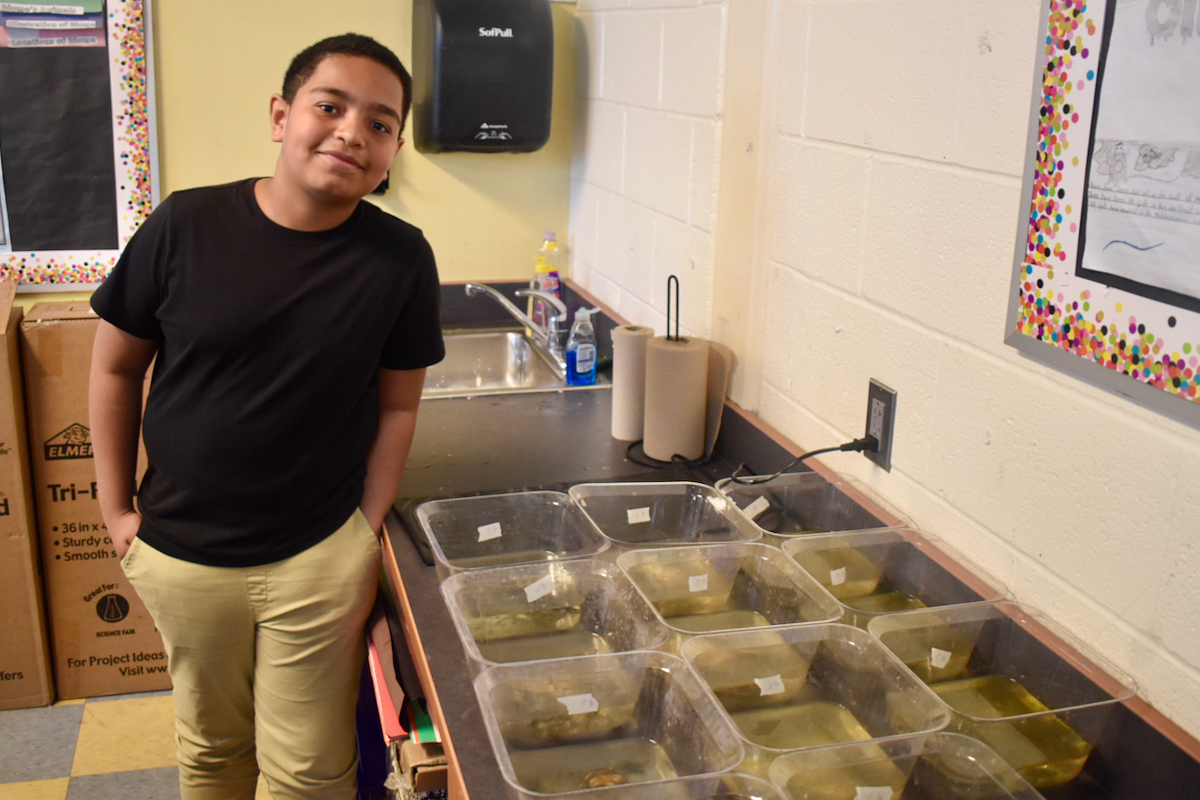
Maya McFadden photos
Clemente sixth-grader Luis with oily oyster science experiment.

With science fair judge Robin Querker.
Will oysters survive if submerged in motor oil?
Roberto Clemente sixth-grader Luis set out to answer that question — as he crafted a locally relevant science fair project focused on environmental harms to New Haven bivalves.
Luis was one of over 100 students who presented the findings of his scientific experiment at Thursday’s school-wide science fair at the 360 Columbus Ave. elementary and middle school.
Roberto Clemente Leadership Academy kindergarten through eighth-grade students put together month-long projects that touched on such topics as astronomy, marine sciences, and the impact of climate change on coastal birds.
Luis focused his research on the effect of oil spills on oysters.

Luis, who is 12 years old, presented on his findings of the effects of oil on native oysters to science fair judge Robin Querker.
“This makes so much sense because there’s an oil terminal down the road,” Querker said once arriving at Luis’ station.
Luis came up with the idea for his project because of his love for sea animals, science and an occasional oyster dinner.
The students spent this past month putting together and executing their science fair projects.
Luis began his work with background research about the impacts of oil spills and on New Haven’s oystering economy and natural environment. He then developed a hypothesis that the oysters would be greatly impacted and killed by a full cup of motor oil in their water.


During the project Luis wondered if the oysters would be able to filter the motor oil once exposed, he said.
Luis used a total of 21 oysters. A third of the oysters were submerged in a cup of oil, seven had a half cup of oil added, and the control group remained in only two cups of salt water.

“I was emotional because the ones with the most oil lost weight and got smaller,” Luis said.
“I was really worried about oil spills that affect them and us,” he added.
During the two-week long project Luis also noticed all of the oysters lost weight, which he attributed to needing more saltwater for them. And a total of four oysters died as a result of the exposure to the motor oil.

Clemente teacher Nancy Wattnem and principal Mia Duff.
Clemente’s science fair was organized by sixth-grade teachers Nancy Wattnem and Nancy Bonilla, who began helping the school to expand its school-wide science fair during the Covid pandemic.
In 2020 Clemente was arranging to host its first ever school-wide science fair until school closures hit due to the pandemic. As a result, Clemente staff encouraged students to conduct science projects from home and dropped off materials at homes.
On Thursday dozens of sixth-grade students presented on their projects in Wattnem and Bonilla’s classrooms to a host of community judges.
Wattnem, a science teacher at Clemente for five years, supported her students with their projects by hosting mini-lessons during class time to learn how to do background research and how to gather evidence.
The students presented on boards decorated with their hypothesis, experiment procedures, data gathered, final conclusions, and personal statements about why their projects were impactful.
“The district has taken a stance on educating our students and getting them prepared for the world of sciences and the pharmaceutical industry,” Wattnem said.

Assistant Superintendent Paul Whyte visits Clemente science fair.
Dozens of the projects had an environmental theme as a result of the students’ recent classroom instruction focused on ecosystems and the human impact on the environment.
Wattnem said she looks forward to future science fairs at Clemente as the district is working to invest in a new and more culturally relevant science curriculum. “New Haven is really becoming a competitor,” she said.
Kindergarten through fourth-grade students conducted classroom projects while the middle-school students were given the choice to work individually or in small groups.
“We let student choice shine with this,” Wattnem added.

Clemente Principal Mia Duff said the fair has grown in student participation every year since its start and this year reached 100 percent student participation.
“The students haven’t had any time to misbehave,” Duff said while emphasizing the impact of hands on learning.
Duff added that the science fair has needed post-remote learning to help students to build their confidence.

Sixth graders Soriangelys Matos and Yesenia Mendez with science fair project.
In Bonilla’s room, sixth-graders Soriangelys Matos and Yesenia Mendez showed off their science experiments focused on the the impact of wind turbines with different numbers of blades. The duo made replicas of wind turbines to test what kind of blades were most impactful.
The two friends put together the entire project in just 10 days, Matos said. They found that metal blades were most durable and cut through the air most effectively and that longer blades captured more wind. And that turbines with more than three blades created stronger wind resistance which slowed the generation of electricity.
“We wanted to work on something that helps to not pollute the air,” she added.
Puerto Rican (Wind) Power


With the click of a battery powered switch Matos showed off a fully powered Puerto Rican community nestled between farm lands and the beach.
“In Puerto Rico they see that it’s possible,” Matos said.

The two also did research on the use of wind power in Puerto Rico. On data graphs the duo showed that Loíza uses more wind power than Connecticut.
In a miniature replica of the town of Loíza the duo showed wind powered homes, farms, and cars with battery-powered turbines.

Sixth grader Soriangelys with wind turbine experiment.
Two additional turbines were created by the partners, one powered by attaching electric wires to both ends of a battery and the other using solar power.

“Their projects are authentic to their interest and abilities,” Bonilla said.
For the fair experiments students learned to conduct controlled work and troubleshooting.

See below for other recent Independent articles about teaching, reading, and working inside New Haven Public Schools classrooms.
• Books In Hand, Teachers Test Reading Pilot
• LGBTQ Sound Students Find A Safe Space
• Career High School Lifts Every Voice & Sings
• Student Inventors Keep Classmates Upright
• Celentano School Assembly Celebrates Jamaican Connection
• Obama School Takes A Day To De-stress
• Student-Artists Build Houses Out Of Blight
• Black Stars Shine Bright In Preschool’s Orbit
• Hillhouse Coach Cheers Teens To School
• Obama Students Caught Being STRONG” At Black History Celebration
• Praise, Frustration Follow Star Teacher’s Departure
• Chess Students Learn Power Of The Pawn
• Facing Down Phones, Riverside Adapts
• Refugee Reader Brings Courage To Class
• Middle-School GSA Finds Its Way
• Student Council Gets Down To Governing
• In Class, High-Schoolers Learn To Lead
• High-Schoolers Get Tips From Future Selves
• TAG Turns Into “Wellness Wednesday”
• Volcano Pose Helps Students Erupt, Cool Off
• Gateway Chief Uncovers Student Superpowers
• New Tutoring Site Focuses On Phonics
• Race Finds A Place In The Classroom
• “Little Engineers” Build Boats For Pirate Pete
• Seeking Stability, Cross Principal Hits The Halls
• Hispanic Heritage Takes Center Stage At Career High Fest
• Teacher Tim Takes To TikTok
• Amid Shortage, Teachers Cite Disrespect



It’s wonderful that the schools are encouraging more STEMM science education and science fairs. These students need to be exposed to those career choices at a young age to build an interest that can develop into higher education and steady living wage careers that will be in high demand for the foreseeable future.
I thank the oysters for their sacrifice in the name of science. Their student scientist may become an ecologist, zoologist, climate change scientist or environmental lawyer who works to create solutions to problems with the environment and hold companies accountable for reducing pollution.